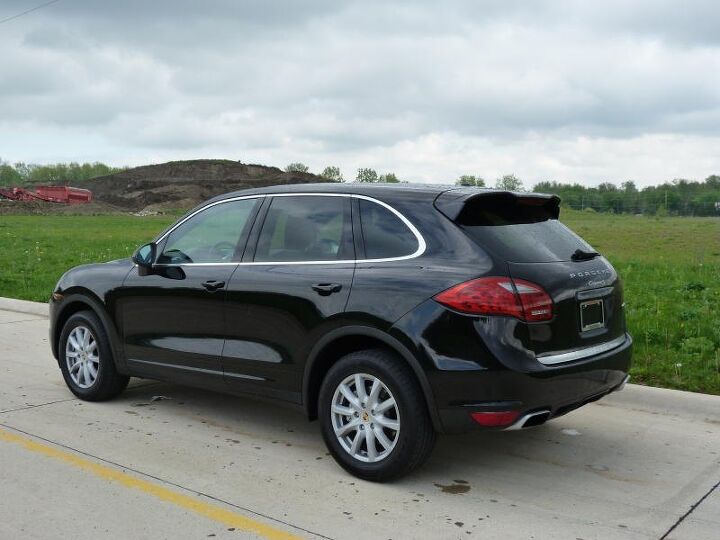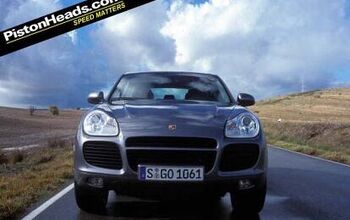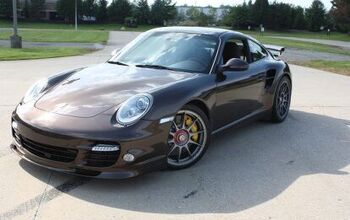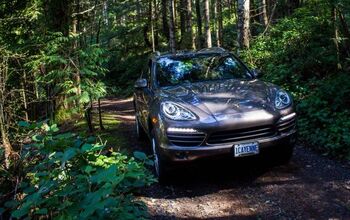Review: 2011 Porsche Cayenne S
Strongly feel that Porsche should stick to sports cars? Personally, I’m willing to cut Zuffenhausen a little slack. Sports car sales, with their boom-and-bust cycles, don’t provide a sound foundation for corporate financial health. A more reasonable test: does Porsche’s entry look and drive unlike any other, in a manner consistent with the marque? Though not pretty, the Panamera passed this test. And the Cayenne SUV?
The initial outlook isn’t good. While the Cayenne’s front end strongly resembles those of other Porsche models, the rest of the exterior can easily be mistaken for an Audi or even a Volkswagen. In fact, the first time I saw the redesigned-for-2011 second-generation Cayenne I thought it was an Audi Q5. One reason: while the Panamera is closely related to no other car, the Cayenne retains close ties with the Volkswagen Touareg, which it also resembles. This isn’t entirely a bad thing. Like the second-generation VW, the 2011 Cayenne is sleeker, better-proportioned, and altogether more attractive than its predecessor.
The Cayenne’s interior is more distinctive than its exterior. Whether by actual dimensional differences or by visual trickery, the instrument panel seems significantly lower and more compact in the Cayenne than in the Touareg. As in the Panamera, the IP rests directly atop an upward-sloping center console (its many buttons closer at hand than they would be in a vertical center stack) to form a subtly tapered “T.” The center console’s upward-angled grab handles (why would the driver need one?) are now mirrored by the door pulls (though the latter are mounted farther forward). Put it all together, and the Cayenne seems sportier from the driver seat than any other SUV. Yet, unlike in the Panamera, there’s no sense that you’re actually in a sports car. The seats (and entire vehicle) would have to be much closer to the ground for that.
Porsche’s interiors have come a long way over the past decade, but the new Cayenne’s still includes too much hard plastic that cannot be mistaken for anything else—even when fitted with the tested car’s upholstered instrument panel and center console. One surprising oversight that provides a poor early impression: the artful door pulls flex and creak when put to their intended use. Form clearly took precedence over function.
The Cayenne’s base front buckets are cushier than the German norm. Though they provide some lateral support, anyone planning to drive this Porsche like a Porsche should pony up another $1,815 for the 18-way power-adjustable sport seats. As in the Touareg, the comfortably high rear seat slides and reclines. In its rearmost position there’s plenty of legroom for all but the tallest adults—but the same can be said of many smaller, lighter compact crossovers. Cargo volume is similarly beyond sufficient but well short of outstanding.
As in the Panamera, engine choices include a 300-horsepower V6, 333-horsepower supercharged hybrid V6, 400-horsepower V8 “S”, and 500-horsepower turbocharged V8 “Turbo.” In the Panamera, the V8 takes the car to an entirely different level. With the Cayenne I sampled only the V8, but drove a Touareg with the V6 in 280-horsepoweer tune immediately beforehand. While the V8 is quicker and more sonorous than the V6, it doesn’t transform the Cayenne like it does the Panamera. Blame two factors. First, while the 4,553-pound 2011 Cayenne S is, commendably, 400 pounds lighter than the 2010 and 740 pounds lighter than the similarly-dimensioned BMW X5 xDrive50i, it remains ten percent heavier than the Panamera. About 70 pounds went with the no-longer-offered two-speed transfer case—Porsche figured out that few owners ventured far off the tarmac. Second, while the V8 is paired with a seven-speed dual-clutch automated manual in the big hatchback, it’s hooked up to a conventional eight-speed automatic in the SUV. Though the Aisin box is perhaps the best of its kind, with quick, nearly imperceptible shifts, the PDK shifts even more quickly and provides a manual-like direct, mechanical connection. Bottom line: in the SUV, the turbo is needed to kick the tail out at will and quicken one’s pulse. The reduced curb weight and additional transmission ratios do significantly improve fuel economy, bumping the V8’s EPA ratings from a dismal 13/19 to a respectable 16/22.
The Cayenne is too large (though not too heavy) to feel as chuckable as compact SUVs like the Audi Q5 and BMW X3 (the upcoming Cajun will target these), but too small to have the road presence of a Cadillac Escalade or Infiniti Q56. The boxes not checked affect its braking and handling. Options include ceramic brakes ($8,150), adaptive dampers ($1,990), air springs (another $1,990), active stabilizer bars ($3,510), torque vectoring ($1,490), and ultra-low-profile ultra-high-performance tires ($1,560-$4,875). The tested Cayenne S had none of these. So perhaps it shouldn’t have come as a surprise that it didn’t steer or handle dramatically better than the Touareg. Yes, the steering was quicker and more communicative, there was less lean in hard turns, and body motions were more tightly controlled, but the difference was a matter of degree, not of kind. As in the VW, you don’t forget you’re driving a tall, heavy vehicle. And so nothing like the difference between the Panamera and its competitors. By the same token, though, the standard suspension Cayenne S only rides a little more firmly than the Touareg, so it’s more day-to-day livable than the hatchback.
You’re not getting an entirely bespoke vehicle with the Cayenne, and its price does reflect this. Outfit a 2011 Cayenne S with Convenience Package (nav, xenons, Bose audio, heated seats, auto-dimming mirrors), obstacle detection, and full-leather interior, and it lists for $71,780. A similarly-equipped Panamera S lists for nearly $95,000. But even relatively inexpensive Porsches are far from cheap. A BMW xDrive50i with the same bits lists for $65,125, and adjusting for remaining feature differences using TrueDelta’s car price comparison tool adds another grand to the heftier, truckier BMW’s price advantage, for a total over $7,500.
In the end, the tested 2011 Porsche Cayenne S doesn’t quite pass my test. From most angles it’s too easily mistaken for an Audi or even a VW. It handles better than competing SUVs, but not dramatically so. The turbocharged V8 and chassis options might well make a big difference. But if one or more of these are needed to render the Cayenne worthy of the Porsche crest, then why offer the SUV without them?
Scott Vollink of Suburban Porsche in Farmington Hills, MI, provided the car. He can be reached at 248-741-7980.
Michael Karesh operates TrueDelta, an online source of automotive pricing and reliability data
Michael Karesh lives in West Bloomfield, Michigan, with his wife and three children. In 2003 he received a Ph.D. from the University of Chicago. While in Chicago he worked at the National Opinion Research Center, a leader in the field of survey research. For his doctoral thesis, he spent a year-and-a-half inside an automaker studying how and how well it understood consumers when developing new products. While pursuing the degree he taught consumer behavior and product development at Oakland University. Since 1999, he has contributed auto reviews to Epinions, where he is currently one of two people in charge of the autos section. Since earning the degree he has continued to care for his children (school, gymnastics, tae-kwan-do...) and write reviews for Epinions and, more recently, The Truth About Cars while developing TrueDelta, a vehicle reliability and price comparison site.
More by Michael Karesh
Latest Car Reviews
Read moreLatest Product Reviews
Read moreRecent Comments
- Jeff JMII--If I did not get my Maverick my next choice was a Santa Cruz. They are different but then they are both compact pickups the only real compact pickups on the market. I am glad to hear that the Santa Cruz will have knobs and buttons on it for 2025 it would be good if they offered a hybrid as well. When I looked at both trucks it was less about brand loyalty and more about price, size, and features. I have owned 2 gm made trucks in the past and liked both but gm does not make a true compact truck and neither does Ram, Toyota, or Nissan. The Maverick was the only Ford product that I wanted. If I wanted a larger truck I would have kept either my 99 S-10 extended cab with a 2.2 I-4 5 speed or my 08 Isuzu I-370 4 x 4 with the 3.7 I-5, tow package, heated leather seats, and other niceties and it road like a luxury vehicle. I believe the demand is there for other manufacturers to make compact pickups. The proposed hybrid Toyota Stout would be a great truck. Subaru has experience making small trucks and they could make a very competitive compact truck and Subaru has a great all wheel drive system. Chevy has a great compact pickup offered in South America called the Montana which gm could be made in North America and offered in the US and Canada. Ram has a great little compact truck offered in South America as well.
- Groza George I don’t care about GM’s anything. They have not had anything of interest or of reasonable quality in a generation and now solely stay on business to provide UAW retirement while they slowly move production to Mexico.
- Arthur Dailey We have a lease coming due in October and no intention of buying the vehicle when the lease is up.Trying to decide on a replacement vehicle our preferences are the Maverick, Subaru Forester and Mazda CX-5 or CX-30.Unfortunately both the Maverick and Subaru are thin on the ground. Would prefer a Maverick with the hybrid, but the wife has 2 'must haves' those being heated seats and blind spot monitoring. That requires a factory order on the Maverick bringing Canadian price in the mid $40k range, and a delivery time of TBD. For the Subaru it looks like we would have to go up 2 trim levels to get those and that also puts it into the mid $40k range.Therefore are contemplating take another 2 or 3 year lease. Hoping that vehicle supply and prices stabilize and purchasing a hybrid or electric when that lease expires. By then we will both be retired, so that vehicle could be a 'forever car'. And an increased 'carbon tax' just kicked in this week in most of Canada. Prices are currently $1.72 per litre. Which according to my rough calculations is approximately $5.00 per gallon in US currency.Any recommendations would be welcomed.
- Eric Wait! They're moving? Mexico??!!
- GrumpyOldMan All modern road vehicles have tachometers in RPM X 1000. I've often wondered if that is a nanny-state regulation to prevent drivers from confusing it with the speedometer. If so, the Ford retro gauges would appear to be illegal.















































Comments
Join the conversation
My wife just LOVES the 2010 Cayenne. Porsche, now that our Cayenne just about paid off,is bombarding us with letters saying "come on in ...we may be able to put you in a new Cayenne with the same payment AND no cash down." I have three of these letters.They know we have a lot of equity in the car. I like my 0.9 % interest rate from Porsche Credit.( In 2010, I found this rate in the NY Times Car Section.0.9 % was about a half page high. The sales guy claimed this rate was not available and/or did not exist til I showed it to him and the owner) Feb 22 Wall Street Journal ran an article on the need for dealers to increase inventory of good used cars. The car is at 48,000 miles with a manufacturer's warranty about to expire. To go to 100.000 miles on the warranty is $4000.Better to put it into the new car? or stick whith the '10? Its been trouble free but new brake pads and tires will be about $1,300 or so in a few months and they are not warranty items. Wife wants to go for the new one at the same payment BUT the dealer just ain't got them. Germany will build one if we can wait til July. (Me...I can wait till the NHL puts a hockey team in Saudi Arabia). We have the 2010 Cayenne base (moon roof, nice audio system, heated wheel, seats,etc.) Fun to drive. Makes my wife happy.That alone is worth serious money. One sales guy offered that Porsche was not 'supporting' the US market by shipping us Yanks anything except the higher end loaded up ones. I like good quality cars, keep them for 6-8 years and do not mind spending money to get value.Keeping wife happy is important also. Do you guys know the real scoop with Porsche, its SUVs , its marketing practices and why we have this interesting oportunity? Got a good buying strategy ??? I am all ears.
I find it funny people bashing these cars to the ground. While the platform is the same with the Touareg it's final assembly and setup are done in Leipzig and not Bratislava (as for Audi and VW). As for the car itself they drive and feel completely different than the Tuaregs. I'm not sure how the reviewer felt there's not too much difference between 280 HP and 400 HP in a lighter car and this fact alone makes me question the value of this review. Switch a Cayman S to Sport mode and it becomes a completely different animal with quick throttle response and ample torque to launch this massive car with surprising agility, think 5.5s to 60mph and 14s quarter mile at 101mph, definite sports car territory as a .85g on the skidpad also is. It is very easy to nitpick at the Cayenne for it is no 911 and I know this first hand. But to dismiss it as simple straight badge engineering is VERY far from the truth about this particular car.